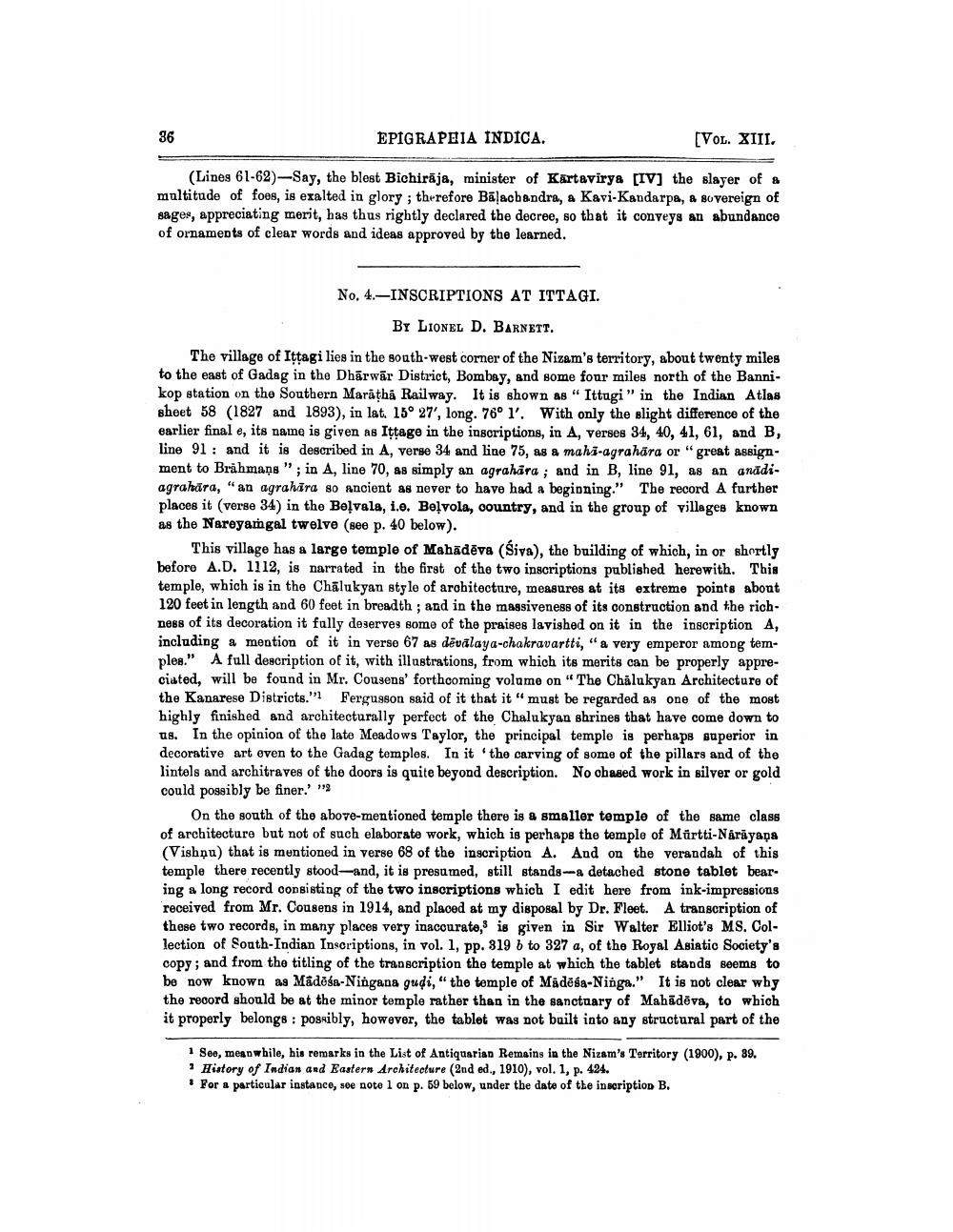________________
EPIGRAPEIA INDICA.
[VOL. XIII.
(Lines 61-62)-Say, the blest Bichirāja, minister of Kartavirya [IV] the slayer of & multitude of foes, is exalted in glory; therefore Bā!acbendra, a Kavi-Kandarpa, a sovereign of sages, appreciating merit, has thus rightly declared the decree, so that it conveys an abundance of ornaments of clear words and ideas approved by the learned.
No, 4.-INSCRIPTIONS AT ITTAGI.
BY LIONEL D. BARNETT. The village of Ittagi lies in the south-west corner of the Nizam's territory, about twenty miles to the east of Gadag in the Dhārwār District, Bombay, and some four miles north of the Bannikop station on the Southern Maratha Railway. It is shown as "Ittugi" in the Indian Atlas sheet 58 (1827 and 1893), in lat. 15° 27', long. 76° 1'. With only the slight difference of the earlier final e, its name is given as Ittage in the inscriptions, in A, verses 34, 40, 41, 61, and B, line 91 : and it is described in A, verse 34 and line 75, as & mahi-agrahara or "great assignment to Brahmans"; in A, line 70, as simply an agrahāra ; and in B, line 91, as an anadi. agrahāra, "an agrahāra so ancient as never to have had a beginning." The record A further places it (verse 34) in the Beļvala, i.e. Beļvola, country, and in the group of villages known as the Nareyamgal twelve (see p. 40 below).
This village has a large temple of Mahādēva (siva), the building of which, in or shortly before A.D. 1112, is narrated in the first of the two inscriptions published herewith. This temple, which is in the Chalukyan style of architecture, measures at its extreme points about 120 feet in length and 60 foet in breadth ; and in the massiveness of its construction and the richness of its decoration it fally deserves some of the praises lavished on it in the inscription A, including a mention of it in verse 67 as dēvalaya-chakravartti, "a very emperor among templea." A full description of it, with illustrations, from which its merits can be properly appreciated, will be found in Mr. Cousens' forthcoming volume on "The Chalukyan Architecture of the Kanarese Districts." Fergusson said of it that it must be regarded as one of the most highly finished and architecturally perfect of the Chalukyan shrines that have come down to us. In the opinion of the late Meadows Taylor, the principal temple is perhaps superior in decorative art even to the Gadag temples. In it the carving of some of the pillars and of the lintels and architraves of the doors is quite beyond description. No chased work in silver or gold could possibly be finer."
On the south of the above-mentioned temple there is a smaller temple of the same class of architecture but not of such elaborate work, which is perhaps the temple of Mürtti-Narayana (Vishnu) that is mentioned in verse 68 of the inscription A. And on the verandah of this temple there recently stood-and, it is presumed, still stands- detached stone tablet bear. ing a long record consisting of the two inscriptions which I edit here from ink-impressions received from Mr. Cousens in 1914, and placed at my disposal by Dr. Fleet. A transcription of these two records, in many places very inaccurate, is given in Sir Walter Elliot's MS. Collection of South Indian Inscriptions, in vol. 1, pp. 319 6 to 327 a, of the Royal Asiatic Society's copy; and from the titling of the transcription the temple at which the tablet stands seems to be now known as Mādosa-Ningana gudi," the temple of Mädēga-Ninga." It is not clear why the record should be at the minor temple rather than in the sanctuary of Mahādēva, to which it properly belongs : possibly, however, the tablet was not built into any structural part of the
1 See, meanwhile, his remarks in the List of Antiquarian Remains in the Nizam's Territory (1900), p. 89. 1 History of Indian and Eastern Architecture (2nd ed., 1910), vol. 1, p. 424. . For a particular instance, soe note 1 on p. 59 below, under the date of the inscription B.




